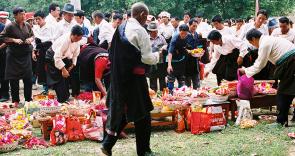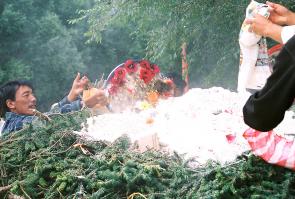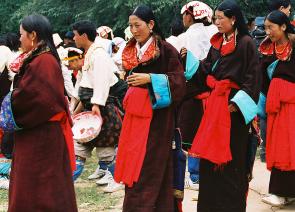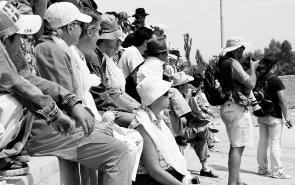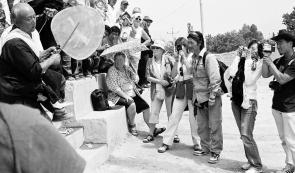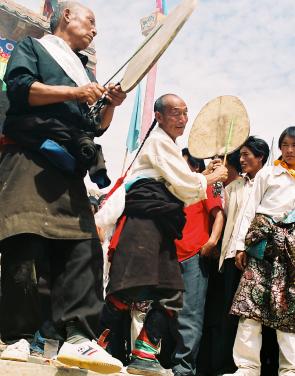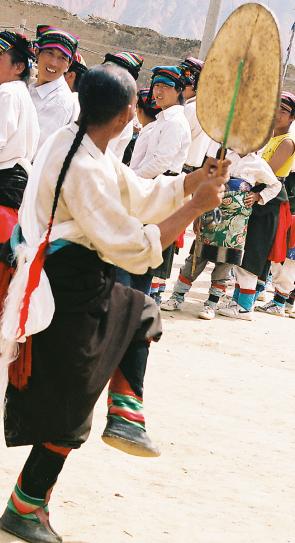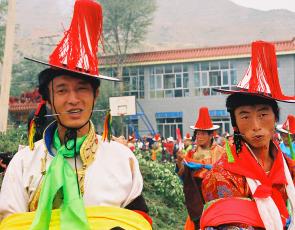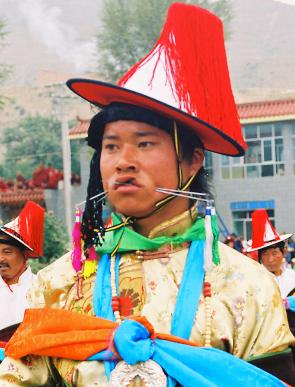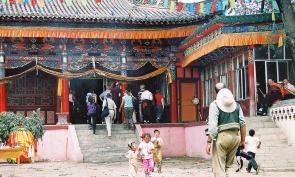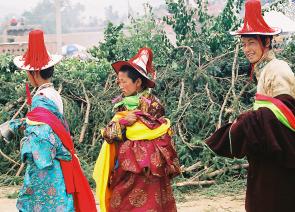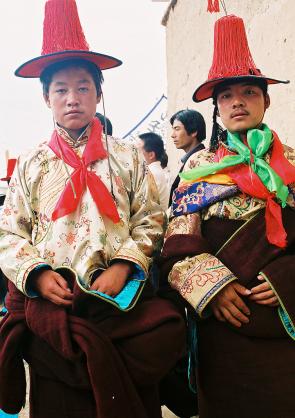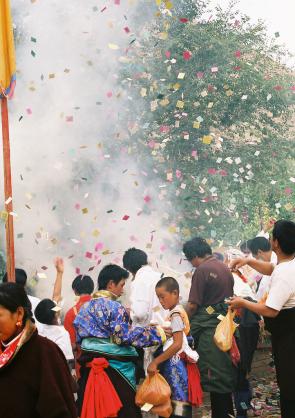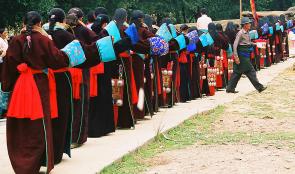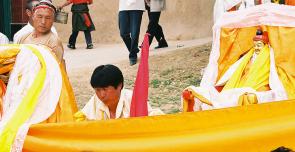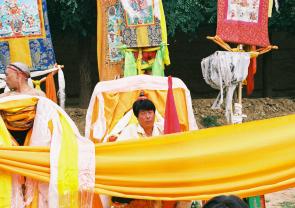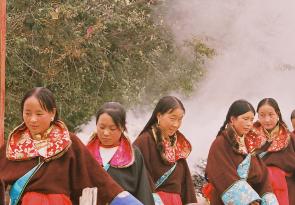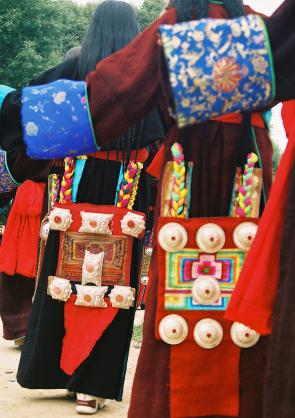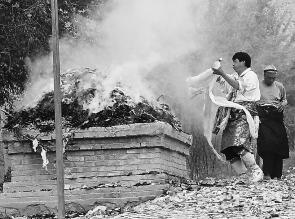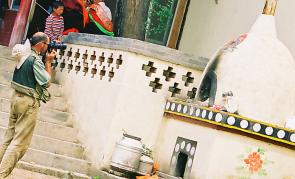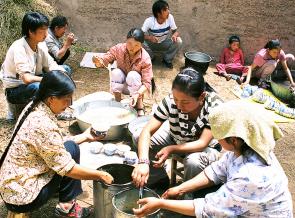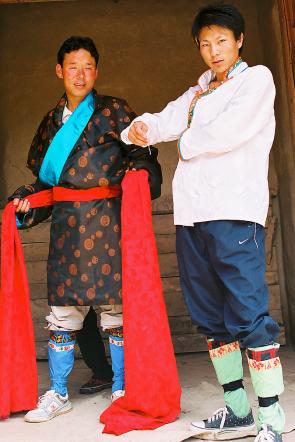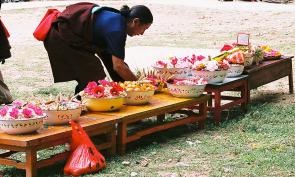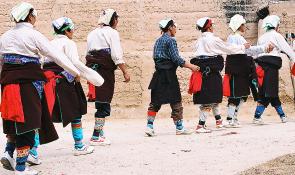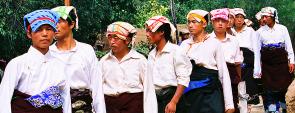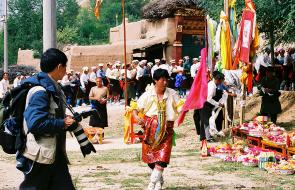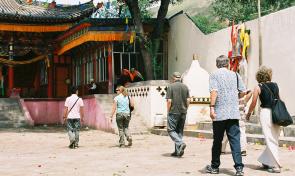In this
chapter Costello focuses on the economics behind recent changes in Tibetan-language
education and cultural products (such as newspapers, books, operas, etc.) in
the Reb gong area. The majority of her information comes from her fieldwork in
Reb gong, including both interviews and surveys. She only cites one source, the
Qinghai Tongji Nianjian from .
In her
section on education, Costello describes the three most common options for
education in Tibetan regions – Chinese language schools, Tibetan schools, and
monastic education – and provides reasons (such as cost and religious reasons) why
Tibetan language schools are most popular among Tibetans in Reb gong (224-225
). She also includes considerable sections on the costs
of education and the economic situation of different groups in Reb gong. Here
she describes the many factors weighing on a family’s decisions when educating
their children, including the increased number of children per family for
ethnic minorities, the increased value of certain jobs versus monastic careers,
the distance and scarcity of Chinese-education schools, the availability of
well-paying jobs and the perceived value of education. She concludes that a
number of factors, including the uncertainty of attaining a well-paying job
after pursuing education, result in a dwindling enrolment rate among the
Tibetans of Reb gong (229 ).
Following
this section on education is a consideration of publication in Reb gong. Here
she considers both books and newspapers. The section on books focuses mostly on
the effects of subsidization on book production, stating that because of
subsidies and donations, Tibetan language books are experiencing a publishing
boom (231-232 ). The description of newspapers deals
mostly with the issue of mandatory subscriptions and the inaccessibility of
Tibetan newspapers to many Tibetan workers (233 ), but
she suggests that growth may also be seen here.
Costello’s
third major section concerns the state of Tibetan performing arts in Reb gong
by considering the economic factors surrounding performing troupes. She divides
troupes into two major groups: those who receive government funding and are
thus obliged to give a certain number of performances a year, and those without
governmental funding but who are still technically part of a governmental work
unit (235 . This section closes with a brief description
of monastic performing arts, such as the cham sacred dances. In her conclusion,
Costello considers the future of education, publication and performance in Reb
gong given current economic situations.
Place Reference:
At the beginning of the ritual, each household brings offerings to the village courtyard where the ritual starts and proceeds from. Tsampa (roasted barley flour), fruits (grapes and apples), breads (all homemade), liquor (barley or rice) and cookies are offered. There are flowers among the offerings as decorations.
When the offering has proceeded to its half-way point, the ritual participants come to the altar with Glung rta (wind horses) and wine to make offerings. After they have made their offerings, they go back to their line and continue circumambulating the courtyard.
While the Lha ba (trance medium) speaks to the male participants, the young village women circumambulate in a slow, systematic step wearing heavy decorations and Tibetan robes.
I was surprised to see so many foreigners during the Klu rol ritual. I was told that some of them are temporary travelers, and that some had lived there for years. During the ritual process, photographers wandered around everywhere without a hint of concern about possibly inconveniencing the participants or villagers. Their cameras kept clicking and no one asked permission.
I was surprised to see so many foreigners during the ritual. I was told that some of them are temporary travelers, and that some had lived there for years. During the ritual process, photographers wandered around everywhere without a hint of worry about possibly inconveniencing the participants or villagers. Their cameras kept clicking and no one asked permission.
Two old men dance with their drums.
An old man dances with his drum in the Klu rol ritual.
All new participants in the Klu rol ritual have to have their cheeks pierced.
All new participants in the Klu rol ritual have to have their cheeks pierced.
I was surprised to see so many foreigners during the ritual.
All new male participants in the Klu rol ritual have to have their cheeks pierced.
I was surprised to see so many foreigners during the ritual. I was told that some of them are temporary travelers, and that some had lived there for years. During the ritual process, photographers wandered around everywhere without a hint of worry about possibly inconveniencing the participants or villagers. Their cameras kept clicking and no one asked permission.
The two boys in these photos are new participants in the ritual. They have to have their cheeks despite their young age. It looks painful but the participants display little sign of discomfort.
When the offering has proceeded to its half-way point, the ritual participants come to the altar with glung rta (wind horses) and liquor to make offerings. After they have made their offerings, they go back to their line and continue circumambulating the courtyard.
While the Lha ba speaks to the male participants, the young village women circumambulate in a slow, systematic step wearing heavy decorations and Tibetan robes.
After the offering is completed, the participants come close to the Lha ba (trance medium), who sits in front of an image which is covered by offered Kha btags (strips of white cloth). He speaks to the participants in a poetic way. I was told that the Lha ba in these images has never been to school and is unable to read or write. There are terrifying stories about the Lha ba. When he is possessed by the local mountain god, he recites what has happened in the previous year and the sins that villagers have committed.
After the offering is completed, the participants come close to the Lha ba (trance medium), who sits in front of an image which is covered by offered Kha btags (strips of white cloth). He speaks to the participants in a poetic way. I was told that the Lha ba in these images has never been to school and is unable to read or write. There are terrifying stories about the Lha ba. When he is possessed by the local mountain god, he recites what has happened in the previous year and the sins that villagers have committed. Often he is able to name specific people and pinpoints what their sin is.
While the Lha ba speaks to the male participants, the young village women circumambulate in a slow, systematic step wearing heavy decorations and Tibetan robes.
While the Lha ba speaks to the male participants, the young village women circumambulate in a slow, systematic step wearing heavy decorations and Tibetan robes.
The Lha ba (trance medium) makes his offerings just after ritual participants have finished their offerings. He was speaking during the offering process but I didn't hear what was said.
I was surprised to see so many
foreigners during the ritual. I was told that some of them are temporary
travelers, and that some had lived there for years. During the ritual process,
photographers wander around everywhere without a hint of concern about possibly inconveniencing
the participants or villagers. Their cameras kept clicking and no one asked
permission.
I was surprised to see so many foreigners during the ritual. I was told that some of them are temporary travelers, and that some had lived there for years. During the ritual process, photographers wander around everywhere without a hint of concern about possibly inconveniencing the participants or villagers. Their cameras kept clicking and no one asked permission.
Five households in the village invite all the villagers to share a meal which is prepared particularly for this ritual. The feast is served before the ritual begins. Because between fifty to seventy people come to eat, all the village women come to help prepare, bringing bowls and cooking tools with them. Big pots of soup with noodles and meat are served.
After the meal the village men go back to their homes to get ready for the ritual. All ritual participants are required to wear a Tibetan robe and Tibetan long-sleeved shirts. These clothes were traditionally everyday wear, but people don’t wear them very often nowadays. The socks that they wear for the ritual are special in that they are homemade and are very different from the ones people wear in daily life.
At the beginning of the Klu rol ritual each household brings offerings to the village courtyard where the ritual starts and proceeds from. Tsampa (roasted barley flour), fruits (grapes and apples), breads (all homemade), liquor (barley or rice) and cookies are offered. Flowers are placed among the offerings as decoration.
The ritual begins with men circumambulating the courtyard. They walk in a systematical gait as a man beats a drum. This constant beat provides the rhythm to keep their steps together. While the men walk, the Lhaba (trance medium) prepares. The entire village attends this part of the ritual. Women with their children sit nearby and watch.
The ritual begins with men circumambulating the courtyard.
During the ritual process,
photographers wander around everywhere without a hint of concern about possibly inconveniencing
the participants or villagers. Their cameras kept clicking and no one asked
permission.
I was surprised to see so many
foreigners during the ritual. I was told that some of them are temporary
travelers, and that some had lived there for years. During the ritual process,
photographers wander around everywhere without a hint of concern about possibly inconveniencing
the participants or villagers. Their cameras kept clicking and no one asked
permission.
Thar has a
large amount of information on Reb gong generally (rather than in reference to
a specific Bonpo sites) in his article “Bonpo Tantrics in Kokonor Area.” In
particular, he gives a detailed breakdown of the general kinds of rituals
performed annually by the Bonpo gsas khang in the Reb gong (Tongren)
County area, including the names of different rituals, their general length,
number of participants, date, a brief description and general importance
(543-544 ).
In this
chapter Stevenson sketches a history of art in Reb gong since it first gained
national attention. Major themes in the article are the Chinese
interest in China’s ethnic minorities, and the relationship between Tibetan
artists and federal policies on art. He mentions that while “Regong Art” is
extremely popular among Chinese collectors, it is difficult to define,
including at the very least thang ka (including painted, embroidered and
appliqué varieties), statues and ornamental panels (199 ).
Abstract:
Byin 'bebs 'the descent of blessings' is an ecstatic state and expression of faith among the Bon community in Reb gong County, Rma lho Tibetan Autonomous Prefecture, Qinghai Province, China, associated with the biannual Chos thog chen mo ritual. After, the descent of blessings was not seen again. Bon adherants believe that blessings will descend if they are in the presence of a sufficiently powerful deity or bla ma and if their faith is strong enough. The ecstatic state is evident in dramatic changes in facial expressions, crying, laughing, dancing, jumping, the making of ritual gestures, and spontaneous uttering of prayers. This article introduces the Bon community of Reb gong, examines the descent of blessings in its ritual context, presents the phenomenon's recent history, and provides first-person accounts from those who have experienced the descent of blessings.
